Knowing where to place a heating pad to treat anything from a UTI to constipation, sciatica, and menstrual cramps is important in making the best of thermal therapy at home.

As for safety and quick pain relief, you’ll also need to know how to use a heating pad and avoid risks such as burns and overuse.
In this post, you’ll find exactly where to put a heating pad for a UTI, sciatica, constipation, and menstrual cramps, and the best and safest ways to use a heating pad at home.
Overview
- Where to Place a Heating Pad for UTI
- Where to Place a Heating Pad for Constipation
- Where to Place a Heating Pad for Sciatica
- Where to Put a Heating Pad for Period Cramps
- How Long Should You Use a Heating Pad?
- Can You Sleep on a Heating Pad?
- How Long Should You Use a Heating Pad?
- Can You Use a Heating Pad While Pregnant?
- Can You Use a Heating Pad in a Car?
Where to Place a Heating Pad for UTI
Since a urinary tract infection can cause pain in the lower abdomen (bladder area) and the lower back area (kidney area), place a heating pad on both areas.
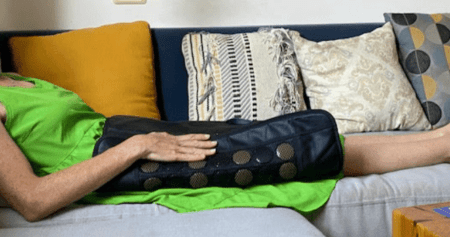
To treat both areas at the same time, you’ll need two small heating pads or one flexible, extra-large heating pad that you can wrap around the entire lower torso.
According to studies, it is best to use a moist heating pad for a UTI because warm water promotes urination and relieves urinary retention.
Use the heating pad for up to one hour, and use a lower temperature if you use it directly on your skin, to avoid burns.
If you have to stay on the move, we recommend a portable heating pad that you can use on the go or at work.

Thermal therapy is very helpful for easing UTI symptoms, especially pain and bladder pressure. It feels very relaxing and can help you fall asleep, which is one of the best remedies for any disease.
If you use a regular heating pad, make sure it shuts off automatically and do not use it for more than an hour twice a day, while checking to see if your skin isn’t burning.
I always use an infrared heating pad, because the heat penetration is deepest and the EMF radiation is lowest.
Some people like to use stick-on heating pads – which are discrete under the clothes and keep the area heated for at least 6 hours. On the other hand, they are more expensive in the long run since they are for single use.
Where to Place a Heating Pad for Constipation

Here’s to use a heating pad for constipation:
Place a large heating pad on your entire abdomen – from the stomach area to the intestines – for a holistic treatment of the entire digestive system.
It has to be large enough to cover your abdomen.
When you apply gentle heat to the abdomen, it travels through the skin to stimulate blood circulation and ease the tense muscles that control bowel activity.
This helps promote a smoother bowel movement and gastric emptying.
Gentle heat is also safe and effective for treating constipation in pregnant women, without harming the uterus.
Make sure your heating pad has an auto shut-off in case you fall asleep while using it, and temperature control to prevent skin burns and overheating.
Some experts claim that a heating pad pressed against your belly can help relax your muscles and relieve stress, which can lead to a bowel movement when you wake up in the morning.
How Long and How Often?
You can use a heating pad for constipation any time you feel discomfort, pressure, or bloating – for 30 minutes up to 3 times a day. Constipation relief doesn’t require very high temperatures. Gentle and soothing heat is enough to get things moving.
Where to Place a Heating Pad for Sciatica
To relieve sciatic pain, you’ll need to place a heating pad on your rear pelvis – the area where your sciatic nerve roots originate.
When you feel sciatica nerve pain, numbness, or weakness, one of these nerve roots has become compressed and inflamed.
The pain tends to travel down the legs, but it’s best to use thermal therapy on the original site of the pain – the lower back.
Heating the legs won’t be effective because it is a side effect of sciatica, and until you don’t treat the root cause, the leg pain will persist.

When you apply heat to your rear pelvis, your blood vessels dilate and supply more oxygen and nutrients to promote healing, and it will decrease spasms and tension in the surrounding muscles, and increase the range of motion in your lower back.
We recommend using this temporary range of motion increase to do some of the best spine decompression exercises for the lower back.
How Long and How Often?
The symptoms of sciatica can be relieved or reduced very quickly and effectively by the soothing effect of thermal therapy on the lower back.
Use your heating pad for at least 20-40 minutes, up to twice a day. No need to continue when symptoms disappear.
Where to Put a Heating Pad for Period Cramps
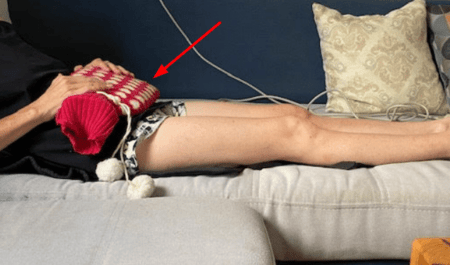
To treat menstrual cramps, place a small to medium heating pad on the lower abdomen.
If you suffer from back pain as well, use a wrap-around heating pad to cover the entire pelvic area.
Using a heating pad is one of the best and most known ways to relieve menstrual cramps quickly.
However, make sure not to use it for more than 15 minutes on bare skin, if you prefer a higher temperature setting.
Recent studies conclude that heat therapy can ease tension in the uterine, pelvic, and abdominal muscles and reduce the associated muscle spasms.
See the 7 best heating pads for menstrual cramps
Many women like to use a hot water bottle to treat period pain because it is usually the exact size needed to cover the front pelvic area and has a psychologically soothing effect as well.
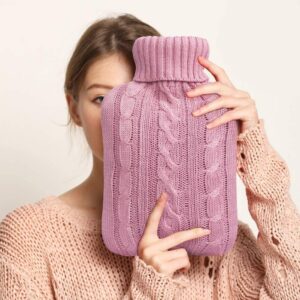
I prefer using a jade infrared heating belt, which has no EMF radiation, the heat penetrates deeper, and the temperature can be set to the exact one that makes you feel most comfortable.
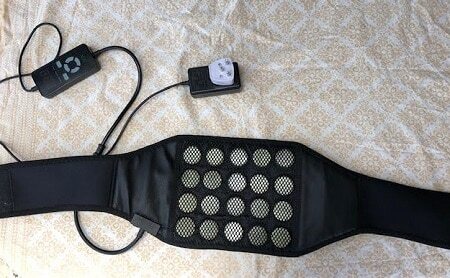
How Long Should You Use a Heating Pad?
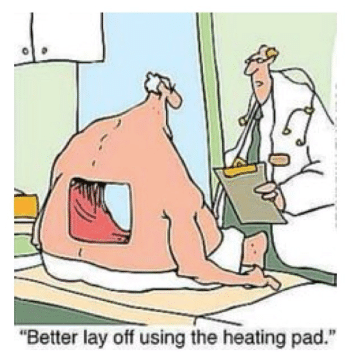
Generally, there is no limit to using a heating pad, as long as you feel comfortable, the temperature is not too high, and you stay hydrated.
However, the type of your heating pad and the way you use it can limit the time you can use it.
It’s like staying outside in the sun, which is the most natural type of thermal therapy.
According to studies, short durations (15 to 20 minutes) will be enough to treat acute and minor back tension, while longer durations (30-45 minutes) are recommended for chronic pain or severe pain. It is not recommended to sleep with a heating pad the entire night.
If you use a heating pad at a low temperature, you can safely go on for up to 2 hours, as long as you stay hydrated and do not use it directly on your skin.
Can You Sleep on a Heating Pad?
As a general rule, it is not considered safe to sleep on a heating pad for the entire night, because it may cause skin burns and dehydration (used at high temperatures).
However, many people around the world fall asleep on a heating pad and set a timer to turn it off after a couple of hours.
Others use heating pads that allow for 6 hours of continuous heat, but you’ll have to make sure it is set to a low temperature and drink at least one cup of water before you go to sleep.
How Long Should You Use a Heating Pad?
The treatment time of a heating pad depends on the type, the temperature you choose, the specific condition you want to relieve, and your body’s reaction to the heat.
The general recommendation is 15-30 minutes once or twice a day.
However, relieving muscle and joint pain requires at least 45 minutes at medium heat to make the most of the treatment, while period cramps require 30 minutes at a higher temperature (120 F and up) to make a difference.
People with heat sensitivity should always start at a lower temperature and gradually increase it to the point they feel comfortable only.
You’ll need to listen to your body and remove the heating pad or lower the temperature if you feel any discomfort or pain.
Can You Use a Heating Pad While Pregnant?
It’s fine to use a heating pad to find relief from pregnancy-related aches and pains in your back, hips, and joints. But avoid using it for longer than 20 minutes.
Start with the lowest setting, and make sure you don’t fall asleep with it.
You can also try a microwaveable heat pack or a hot water bottle, which will cool off naturally after about 15-20 minutes.
Do not use a heating pad on your abdomen.
Can You Use a Heating Pad in a Car?
Yes, you can use a heating pad in a car while you are driving. For this purpose, you’ll need a heating pad that plugs into the car – a 12V heating pad.
The best ones come with a handheld remote control and allow you to set the heat level you want.
Before You Go…
I and my family use heating pads (mainly infrared ones) extensively and consider them our home doctors.
We use them for anything from cold and flu relief to back pain, strained muscles, and sports injuries, or just to keep ourselves toasty warm and relaxed in the winter.
For back pain, we highly recommend combining the wonderful thermal therapy with home back traction devices to get the most out of your drug-free home back pain treatment.
To your health and happiness,
The Back Pain Relief Products Team
Studies
Afazel MR, Jalali E, Sadat Z, Mahmoodi H. Comparing the effects of hot pack and lukewarm-water-soaked gauze on postoperative urinary retention; a randomized controlled clinical trial. Nurs Midwifery Stud. 2014 Dec;3(4):e24606.
Nagashima Y, Igaki M, Suzuki A, Tsuchiya S, Yamazaki Y, Hishinuma M, Oh-Ishi S, Majima M. Application of a heat- and steam-generating sheet increases peripheral blood flow and induces parasympathetic predominance. Evid Based Complement Alternat Med. 2011;2011:965095.
Jo J, Lee SH. Heat therapy for primary dysmenorrhea: A systematic review and meta-analysis of its effects on pain relief and quality of life. Sci Rep. 2018 Nov 2;8(1):16252.

